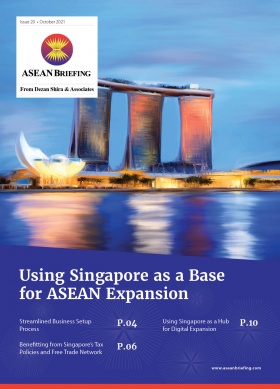Singapore Introduces New Incentives to Encourage Greener Ships
Singapore’s Maritime Port Authority has issued new incentives for Singapore-flagged ships that undertake decarbonization efforts. The incentives include a reduction in the initial registration fees of between 20 to 100 percent for new ships registering on Singapore’s Registry of Ships as well as tax rebates on the annual tonnage tax.
Singapore’s maritime industry is vital to its economy, as the country is strategically located near the Straits of Malacca, one of the world’s busiest shipping lanes. Singapore already handles over 600 million tons of cargo annually, showcasing the importance of the country’s maritime industry and its ports to global trade.
On April 22, 2022, Singapore’s Maritime Port Authority (MPA) issued new incentives for Singapore-flagged ships under the Green Ship Program (GSP). The program offers discounts on initial registration fees (IRF) of between 20 and 100 percent for existing ships and those about to register to Singapore’s Registry of Ships (SRS).
The GSP was first commenced in 2011 and is designed to reward ship owners who voluntarily modify their vessels to exceed the environmental standards set by the International Maritime Organization (IMO). The new incentives are available from May 1, 2022, until December 31, 2024.
Established in 1966, the SRS is the fifth-largest in the world, with more than 4,400 on its register that aggregate over 96 million gross tons. The SRS’ fleet contains mostly tankers, container ships, and bulk carriers for transporting goods around the world from Singapore’s ports — which are among the busiest in the world — Further, the SRS fleet also contains floating production storage and offloading to support the country’s oil and gas industry — Singapore is also one of the world’s top three oil trading and refining hubs.What are the incentives?
The MPA will provide incentives to Singapore-flagged ships that fulfill one of the following conditions:
- Exceed the IMO’s Phase 3, Energy Efficiency Design Index (EEDI) requirements by 10 percent;
- Adopt an engine capable of using low-carbon fuels with CF (conversion factor between fuel consumption and CO2emission) equivalent to or lower than LNG (i.e. (bio)-LNG, (bio)-methanol, (bio)-ethanol); or
- Adopt an engine capable of using zero-carbon fuels as its primary fuel source (e.g. ammonia, hydrogen).
A new ship that exceeds the IMO’s Phase 3 EEDI requirements by the 10 percent margin or more will enjoy a 50 percent reduction for the IRF. Further, the ship will enjoy a 20 percent rebate on the Annual Tonnage Tax (ATT) that is payable every year. Shipowners should refer to Annex B in the incentive for the ship size and the timeline the financial incentives will be applied.
Existing ships already on the SRS will not be eligible for the 40 percent reduction in the IRF but will be eligible for the 20 percent ATT rebate.
New ships that are able to adopt low-carbon fuels are eligible for a 75 percent reduction for the IRF and a 50 percent rebate on the ATT. Existing ships will only enjoy the 50 percent ATT rebate. Annex C of the incentive provides the list of fuels that corresponds to the ‘low-carbon’ fuel requirement.Finally, ships using zero-carbon fuels as their primary fuel will enjoy a 100 percent reduction in the IRF and a 100 percent rebate on the ATT.
How can shipowners qualify for the incentives?
To qualify for the GSP in the EEDI criterion, shipowners must submit a copy of the International Energy Efficiency (IEE) Certificate and proof that the EEDI of the ship has exceeded the IMO’s requirements, for that specific ship type.
For the zero and low-carbon fuel criterion, shipowners must submit an International Air Pollution Prevention (IAPP) Certificate and an Engine International Air Pollution Prevention (EIAPP) Certificate with any other relevant supporting documents.
Once a ship qualifies for an incentive, the MPA will issue a ‘Green Letter of Recognition’.
Singapore’s maritime industry is a key pillar of the economy
The SRS’ high shipping standards are a testament to Singapore’s maritime industry, which is not only a key pillar of the country’s economy but also to trade in Asia.
Singapore’s strategic location on the Strait of Malacca — one of the world’s busiest shipping lanes — coupled with investments in maritime and port infrastructure has transformed the country into one of the largest transshipment hubs in the world. There are over 5,000 maritime companies operating in the country, which includes 130 international shipping groups.
The Port of Singapore is connected to 600 ports in over 120 countries and handles over 37 million twenty-foot equivalent units (TEUs) of containers and over 600 million tons of cargo annually. The government has plans to expand this capacity when the Tuas Port project is expected to be completed by 2040. This will be the world’s largest container terminal with the ability to handle up to 65 million TEUs per year, 50 percent more than the current capacity.
Further, the Singapore government aims to attract over S$20 billion (US$14.5 billion) in investments by 2024. As such, for an economy that is mainly export-driven, the importance of Singapore’s ports cannot be understated.
Further Reading
- Singapore to Implement New Points System for Employment Pass Applicants From 2023
- Singapore to Reap Long-Term Benefits Under RCEP
- New Criteria for Family Offices in Singapore to Receive Tax Incentives
About Us
ASEAN Briefing is produced by Dezan Shira & Associates. The firm assists foreign investors throughout Asia and maintains offices throughout ASEAN, including in Singapore, Hanoi, Ho Chi Minh City, and Da Nang in Vietnam, Munich, and Essen in Germany, Boston, and Salt Lake City in the United States, Milan, Conegliano, and Udine in Italy, in addition to Jakarta, and Batam in Indonesia. We also have partner firms in Malaysia, Bangladesh, the Philippines, and Thailand as well as our practices in China and India. Please contact us at asia@dezshira.com or visit our website at www.dezshira.com.








